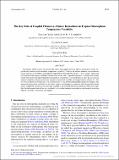The Key Role of Coupled Chemistry–Climate Interactions in Tropical Stratospheric Temperature Variability
Author(s)
Yook, Simchan; Thompson, David WJ; Solomon, Susan; Kim, Seo-Yeon
DownloadPublished version (1.887Mb)
Publisher Policy
Publisher Policy
Article is made available in accordance with the publisher's policy and may be subject to US copyright law. Please refer to the publisher's site for terms of use.
Terms of use
Metadata
Show full item recordAbstract
© 2020 American Meteorological Society. The purpose of this study is to quantify the effects of coupled chemistry–climate interactions on the amplitude and structure of stratospheric temperature variability. To do so, the authors examine two simulations run on version 4 of the Whole Atmosphere Coupled Climate Model (WACCM): a ‘‘free-running’’ simulation that includes fully coupled chemistry–climate interactions and a ‘‘specified chemistry’’ version of the model forced with prescribed climatological-mean chemical composition. The results indicate that the inclusion of coupled chemistry–climate interactions increases the internal variability of temperature by a factor of;2 in the lower tropical stratosphere and—to a lesser extent—in the Southern Hemisphere polar stratosphere. The increased temperature variability in the lower tropical stratosphere is associated with dynamically driven ozone–temperature feedbacks that are only included in the coupled chemistry simulation. The results highlight the fundamental role of two-way feedbacks between the atmospheric circulation and chemistry in driving climate variability in the lower stratosphere.
Date issued
2020Department
Massachusetts Institute of Technology. Department of Earth, Atmospheric, and Planetary SciencesJournal
Journal of Climate
Publisher
American Meteorological Society